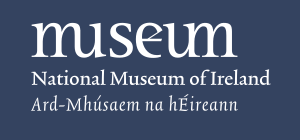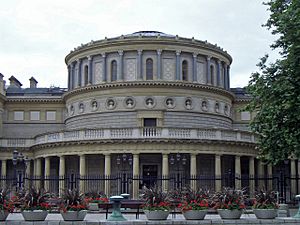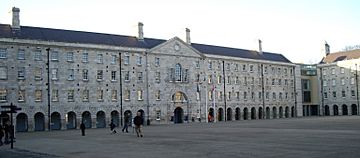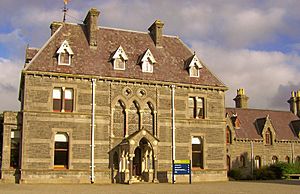National Museum of Ireland facts for kids
| Ard-Mhúsaem na hÉireann | |

The current logo of the museum
|
|
| Established | 14 August 1877 |
|---|---|
| Location | Dublin and Castlebar, Ireland |
| Type | National museum |
| Collection size | Almost 4,000,000 items |
| Visitors | All branches: 1,315,776 (2016) |
| National Museum of Ireland network | |
The National Museum of Ireland (Irish: Ard-Mhúsaem na hÉireann) is Ireland's main museum. It focuses on Irish history, Irish art, culture, and natural history. It also has collections about archaeology from Ireland and other countries.
The museum has four different locations. Three are in Dublin:
The fourth location is the Country Life Museum in County Mayo.
Contents
A Look Back: The Museum's History
The National Museum of Ireland grew from older collections. These collections belonged to groups like the Royal Dublin Society (RDS) and the Royal Irish Academy (RIA). In the 1700s, the RDS started collecting rocks and minerals. They wanted to help people learn about Ireland's natural resources.
One of the first big collections was bought in 1792. It was called the Leskean Cabinet. These early collections were shown to the public in different buildings. Eventually, they moved to Leinster House in 1815.
How the Museum Got Its Name
In 1832, a professor named Karl Ludwig Giesecke first called it the "National Museum of Ireland." At that time, the collections were open to the public a few days a week.
People soon realized a new, bigger museum was needed. This led to the building that now holds the Natural History Museum. It is located on Merrion Street. In 1851, Alexander Carte became the curator. He helped organize and grow the collections.
The museum took part in a big art and industry exhibition in 1853. After this, it was open to the public five days a week.
The museum officially became the Science and Art Museum in 1877. Later, it was renamed the National Museum of Science and Art in 1900. After Ireland became independent, it became the National Museum of Ireland. The main building for archaeology and history opened in 1890. It was designed by Sir Thomas Newenham Deane and his son.
The Museum Today
For many years, the museum operated from its buildings on Kildare Street and Merrion Square. Later, new locations were opened at Collins Barracks and in County Mayo. Today, the museum continues to collect and display amazing items.
Explore the Museum's Locations
The National Museum of Ireland has four exciting places to visit. Each one focuses on a different theme.
Archaeology: Discover Ancient Ireland
The National Museum of Ireland – Archaeology is on Kildare Street in Dublin. Here, you can see amazing items from Ireland's past.
- Prehistoric Ireland: See early gold artwork and treasures from ancient churches.
- Viking and Medieval Times: Explore objects from the Vikings and the medieval period.
- Kingship and Sacrifice: This exhibit features well-preserved bog bodies. These are ancient human remains found in bogs.
- World Treasures: There are also special displays of items from Egypt, Cyprus, and the Roman world.
This museum is home to famous examples of early medieval Celtic metalwork. These include the Ardagh Chalice, the Tara Brooch, and the Derrynaflan Hoard. You can also see prehistoric pieces like the Iron Age Broighter Gold and many Bronze Age gold necklaces called lunulas. Many of these treasures were found by accident long ago.
The museum also has the mummy of an Egyptian woman named Tentdinebu.
Decorative Arts and History: Art, Fashion, and Military Stories
The National Museum of Ireland – Decorative Arts and History is located at Collins Barracks. This used to be a military base. It was named after Michael Collins in 1922. This location opened in 1997. It also has the museum's offices, a shop, and a coffee shop.
Here, you can see:
- Beautiful Objects: Displays of furniture, silver, ceramics, and glassware.
- Everyday Life: Examples of folk life, costumes, money, and weapons.
- Famous Art: A rare Chinese porcelain vase from around 1300 AD, called the Fonthill vase.
- Soldiers & Chiefs: This exhibition tells Ireland's military history from 1550 to today. It features military items and memories.
The museum often has special exhibitions. For example, in 2007, replicas of six Irish High Crosses were shown here.
Natural History Museum: The Dead Zoo
The Natural History Museum is on Merrion Street in Dublin. Many locals call it the "Dead Zoo." It has specimens of animals from all over the world. Its collection and old-fashioned look have not changed much since the early 1900s. It's like stepping back in time to see how museums used to be!
Country Life: Life in Rural Ireland
The Country Life Museum is the newest part of the National Museum. It opened in 2001. You can find it near Turlough village in County Mayo.
This museum focuses on how ordinary people lived in rural Ireland. It covers the mid-1800s to the mid-1900s. Many items show what life was like in the 1930s. You can see displays about:
- Homes and daily chores
- The natural environment
- Local communities
- Changes that happened over time
Who Runs the Museum?
A board of directors oversees the National Museum. Some directors are chosen by the Royal Irish Academy and the Royal Dublin Society. These groups helped start the museum. Others are appointed by the government.
The museum is led by a Director. The current Director is Lynn Scarff, who started in 2018.
See also
 In Spanish: Museo Nacional de Irlanda para niños
In Spanish: Museo Nacional de Irlanda para niños




